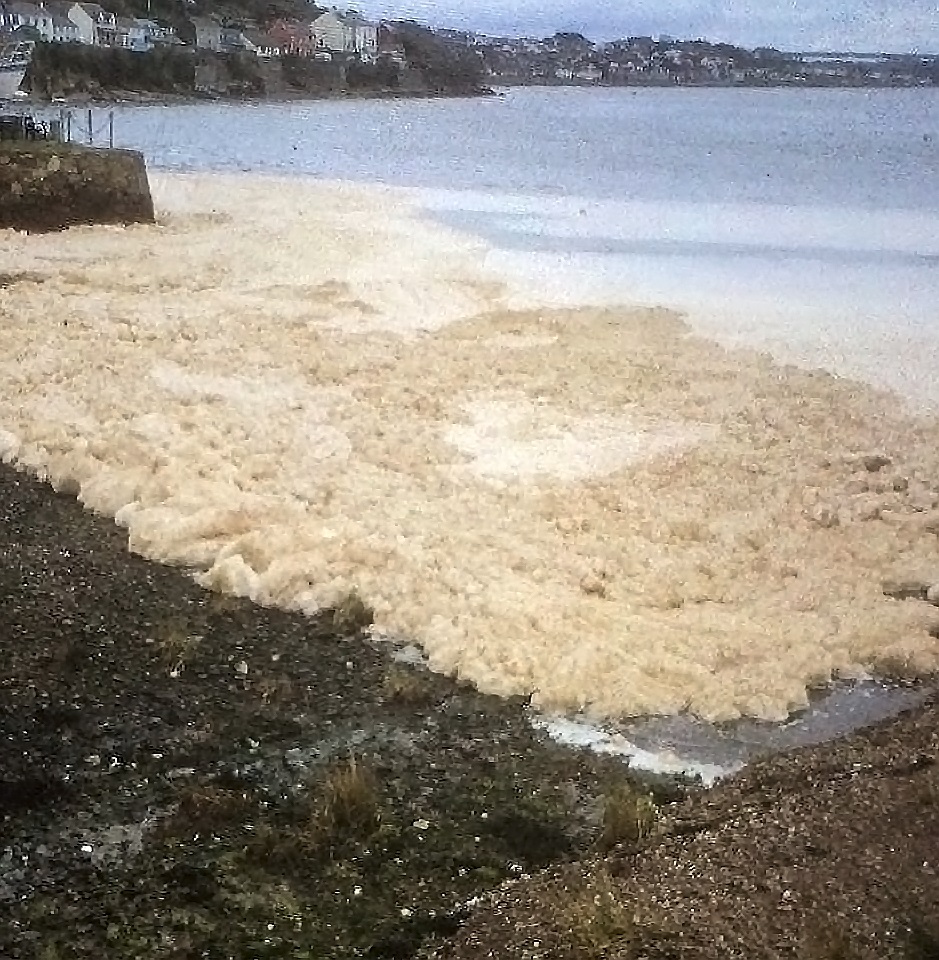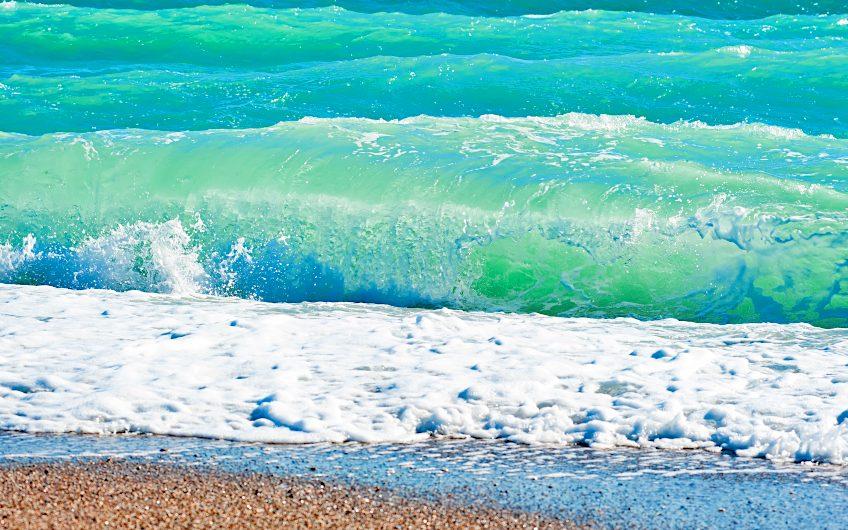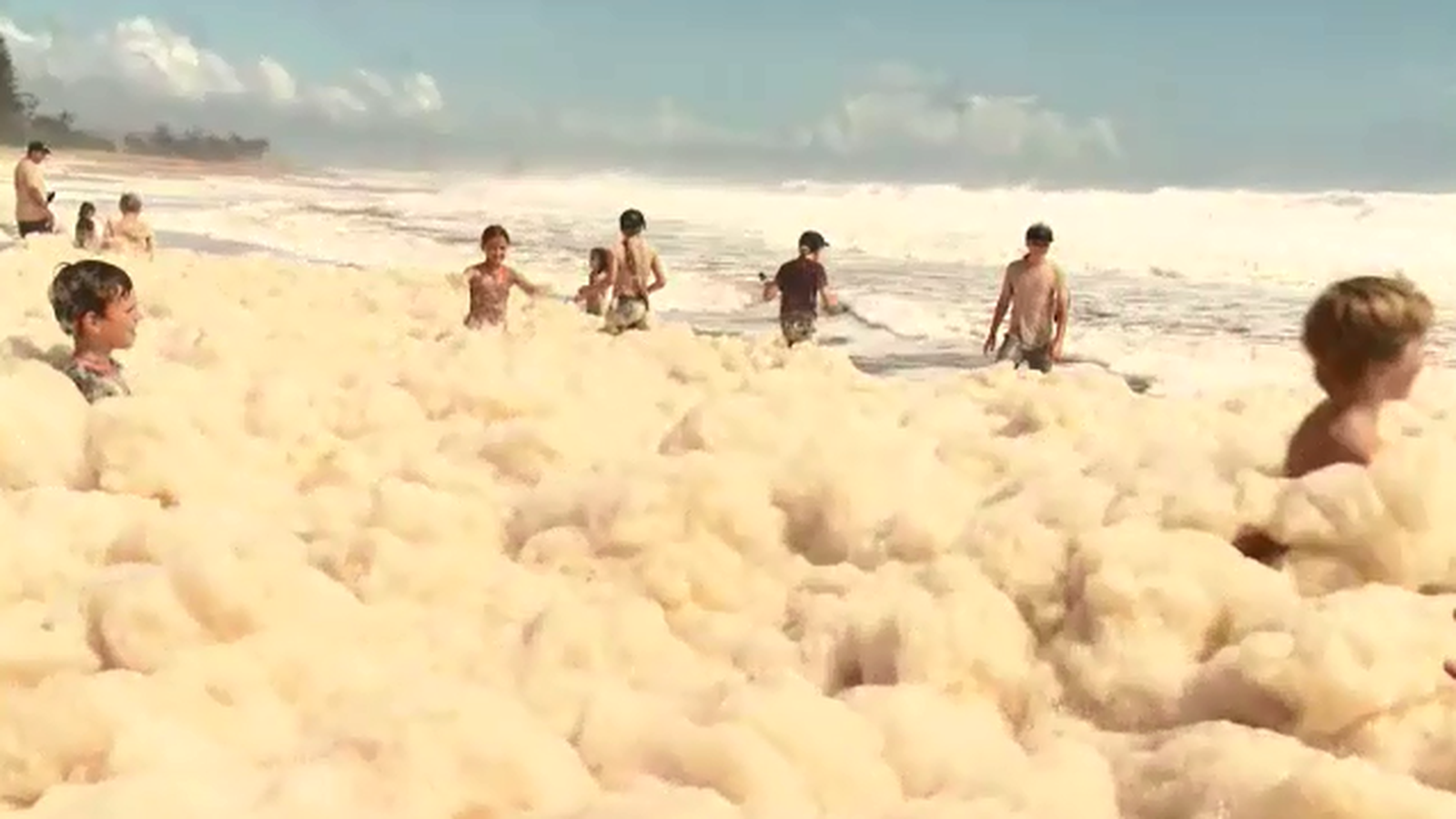Most sea foam is not harmful to humans and is often an indication of a productive ocean ecosystem. Color plays a large part in what makes up the Sea foam. What are the colors of Sea Foam?
Sea foam can appear in various colors, including white, brown, green, yellow, red, blue, and even purple. These colors result from factors like organic matter, algal pigments, and environmental conditions, reflecting the diverse dynamics of coastal ecosystems.
Algal blooms are one common source of thick sea foams. When large algae blooms decay offshore, great amounts of decaying algal matter wash ashore. Foam forms as this organic matter is churned up by the surf.
Table of Contents
ToggleIntroduction:
The color of sea foam can vary depending on several factors, including the presence of organic matter, algae, and other substances. Typically, sea foam appears white, resulting from the scattering of light by the small bubbles in the froth. However, color variations can occur. Brown sea foam, for example, indicates the presence of additional organic materials, such as decaying plant matter and algae. The coloration of sea foam provides insights into the composition of the surrounding marine environment and can be influenced by both natural processes and human activities.
Sea Foam Colors
Sea foam colors vary depending on several factors such as the concentration of organic matter, minerals, and algae in the water, as well as the lighting conditions and environmental factors. In pristine coastal areas where the water is clear and unpolluted, sea foam often exhibits a delicate shade of pale blue or turquoise, reflecting the pristine beauty of the ocean.
In contrast, in areas with high concentrations of organic material or algae blooms, sea foam can take on a more yellowish or greenish hue, indicative of the presence of nutrients and microscopic organisms.
Additionally, during certain weather conditions such as storms or rough seas, sea foam may appear whiter or even brownish as it churns and mixes with sand and sediment from the ocean floor. Despite its varying colors, sea foam always remains a captivating and ephemeral reminder of the dynamic and ever-changing nature of the marine environment.
Seafoam typically exhibits a range of colors, often resembling the hues found in ocean waters. The specific colors of seafoam can vary based on factors such as the presence of impurities, organic matter, and the angle and intensity of light. Here are common colors associated with seafoam:
- White:
- Pure, clean seafoam often appears white. This color is characteristic of the frothy bubbles formed by the churning of ocean waves.
- Light Blue-Green:
- Seafoam commonly reflects the colors of the surrounding water. It often takes on shades of light blue-green, similar to the color of the ocean itself.
- Pale Green:
- Depending on the presence of algae or other organic matter, seafoam may have a pale green tint. This coloration can result from the interaction of sunlight with dissolved organic compounds.
- Translucent:
- In its thinnest areas, seafoam can appear almost translucent. This transparency allows light to penetrate, creating a delicate and ethereal quality.
- Iridescent:
- Under certain lighting conditions, seafoam may exhibit iridescence, displaying a play of colors similar to the shimmering effect seen on soap bubbles. This effect is caused by the interference of light waves.
- Gray or Brownish Tints:
- Seafoam near coastal areas might take on gray or brownish tints due to the presence of sediment, minerals, or pollutants in the water.
- Rainbow Effects:
- When sunlight interacts with seafoam, particularly at specific angles, rainbow-like effects may occur, adding a spectrum of colors to the foam.
It’s important to note that the colors of seafoam can be dynamic and may change based on environmental conditions. Additionally, the appearance of seafoam may vary from one location to another, influenced by factors such as water composition, weather, and the presence of marine life.
White Sea Foam: The Standard Phenomenon
White sea foam is the quintessential phenomenon observed along coastlines worldwide, captivating beachgoers and marine enthusiasts alike. Created through the mechanical action of waves breaking against the shore, sea foam consists of countless tiny air bubbles trapped within the water, giving it a frothy, white appearance.

This natural occurrence is a result of organic matter, such as proteins and lipids, being agitated and churned by the waves, forming a foam that blankets the water’s surface. White sea foam is particularly prominent in areas where the ocean meets rocky shores or sandy beaches, where the turbulent action of the waves is most pronounced.
While often associated with the beauty and vitality of the ocean, white sea foam also plays a crucial ecological role by transporting nutrients and organic material between marine ecosystems, contributing to the overall health and biodiversity of coastal environments.
White sea foam is a product of the churning action of waves, leading to the formation of countless tiny bubbles on the ocean surface. These bubbles scatter sunlight, creating the characteristic white appearance of sea foam. The white foam may not be toxic, but that doesn’t mean it’s harmless.
When weather conditions get completely out of control, the churning of the seawater creates a lot of sea foam. Like, a lot. In the winter of 2020, a king tide in Washington state with 25-foot (nearly 8-meter) waves created a “blender effect” that churned up sea foam as high as a man’s chest. Later that spring and halfway around the world, so much sea foam appeared in the Netherlands that it killed five very experienced surfers.
Natural Factors Influencing White Sea Foam:
- The clarity of the water plays a crucial role in determining the whiteness of sea foam. Clear waters allow for effective light scattering by the bubbles.
- Dissolved organic matter, such as proteins and fats, can influence the stability of bubbles, contributing to the overall coloration of the foam.
Aesthetic and Coastal Beauty:
- The white color of sea foam enhances the visual appeal of coastal landscapes, creating a contrast against the blue expanse of the ocean.
- Photographers often capture the aesthetic beauty of white sea foam, and its presence is integral to the picturesque scenes associated with beaches and shorelines.
Brown Sea Foam
Brown sea foam is a remarkable yet lesser-known phenomenon that occurs under specific environmental conditions, typically in coastal areas with high concentrations of organic matter and sediment. Unlike the pristine white foam commonly seen on beaches, brown sea foam takes on a darker, earthier hue due to the presence of decomposing organic material, minerals, and sediment suspended in the water.
This type of foam is often observed after heavy rainfall or during periods of increased river runoff when rivers carry nutrient-rich soil and organic debris into the ocean. As the turbulent waves agitate the water, they mix with these organic particles, causing them to accumulate and form a frothy, brownish foam along the shoreline.
While brown sea foam may not possess the aesthetic appeal of its white counterpart, it serves as a vital component of coastal ecosystems, facilitating the transport of nutrients and organic matter that nourish marine life and contribute to the overall health of coastal habitats.
Understanding the factors that contribute to the formation of brown sea foam provides valuable insights into the interconnectedness of terrestrial and marine environments and underscores the importance of sustainable land and water management practices to preserve coastal ecosystems.

Brown sea foam is a coastal phenomenon characterized by the distinctive brown coloration of the frothy substance that accumulates on the surface of seawater.
This unique color is primarily attributed to the presence of organic matter, including decaying plant material and algae. As waves break along the shore, they trap air and create bubbles, and when these bubbles combine with organic compounds, they contribute to the formation of brown sea foam.
Reddish-brown sea foam: That’s often due to phytoplankton, also known as algae blooms, which is a natural phenomenon. These tiny organisms release toxins that aren’t good for you, your dog, the birds, or anything. The algal toxins can irritate the eyes and ears and even cause respiratory conditions.
Ecological Significance and Nutrient Content:
- The brown coloration often signifies the presence of essential nutrients within the sea foam.
- Ecologically, brown sea foam can provide vital nutrients to marine organisms, supporting coastal ecosystems.
- Human-Induced Factors Contributing to Brown Sea Foam:
Anthropogenic activities, such as pollution and runoff, can introduce pollutants to coastal waters, influencing sea foam color.
Understanding human-induced factors is crucial for assessing the environmental impact of brown sea foam and implementing mitigation measures.
Green and Yellow Sea foam

Observing green and yellow sea foam adds green and yellow sea foam are intriguing phenomena that occur under specific environmental conditions, often associated with factors such as algae blooms and high concentrations of organic matter.
In coastal areas experiencing algal blooms, microscopic algae proliferate rapidly, releasing organic compounds and pigments into the water. When waves agitate the water, these compounds become trapped within the foam, imparting it with a distinctive green or yellow hue. The color intensity can vary depending on the type and density of algae present, as well as other environmental factors such as sunlight and water temperature.
Green and yellow sea foam can be particularly striking against sandy beaches or rocky shores, adding a surreal touch to the coastal landscape.
While visually captivating, these colors may also serve as indicators of ecological changes within marine ecosystems, such as nutrient imbalances or pollution levels.
Understanding the mechanisms behind the formation of green and yellow sea foam can provide valuable insights into the health and dynamics of coastal environments, highlighting the interconnectedness of marine life and environmental factors.
vibrant dimension to coastal environments, highlighting the influence of various factors, from the presence of specific organisms to the unique conditions of the surrounding ecosystem. While white and brown are more common sea foam colors, green and yellow sea foam can also occasionally be observed, indicating unique environmental conditions:
Green Sea Foam:
- Causes: The presence of green sea foam may result from the incorporation of organic matter, such as algae, with chlorophyll pigments.
- Ecological Significance: Green sea foam often signifies the involvement of algae, and its presence may contribute nutrients beneficial to marine life.
- Rare Occurrence: While less common than white or brown, green sea foam can be observed in areas with algal blooms or specific types of marine vegetation.
Yellow Sea Foam:
- Causes: The yellow coloration may be influenced by the presence of certain types of organic materials or pigments.
- Potential Influences: Algal species with yellow or brown pigments, along with dissolved organic matter, can contribute to the yellow appearance of sea foam.
- Environmental Conditions: Yellow sea foam may occur under specific conditions, including variations in water temperature and nutrient levels.
Observing green and yellow sea foam adds to the spectrum of colors present in coastal environments, highlighting the dynamic and diverse nature of these marine ecosystems.

Other Sea Foam Colors
Sea foam can exhibit a diverse array of colors beyond the more commonly observed white, brown, green, and yellow varieties. In certain coastal regions with unique geological features or mineral deposits, sea foam may take on hues such as pink, orange, or even purple.
These colorful foams result from the presence of minerals like iron oxide or organic compounds derived from algae or bacteria. For example, pink sea foam can occur in areas with high concentrations of red algae, which release pigments that tint the foam a rosy hue.
Similarly, orange sea foam may arise from the presence of iron-rich sediments or organic matter, while purple sea foam can be attributed to the presence of specific types of bacteria or phytoplankton.
These vibrant displays of sea foam colors add an extra dimension of beauty to coastal environments, showcasing the intricate interplay between geology, biology, and ocean dynamics. Studying these unique occurrences not only enriches our understanding of marine ecosystems but also underscores the remarkable diversity and resilience of life in the oceans.
Beyond the more common white, brown, green, and yellow sea foam, various other colors can be observed, adding to the visual diversity of coastal environments. Here are the most prevalent ones:
Red Sea Foam:
Red sea foam is a rare and captivating phenomenon that occurs when specific conditions lead to the incorporation of pigments, often from certain types of algae or microscopic organisms. While red sea foam is a rare occurrence, its presence highlights the dynamic and diverse nature of coastal ecosystems, where various factors contribute to the ever-changing palette of sea foam colors.
- Causes: Presence of red or pink pigments from specific types of algae or microscopic organisms.
- Environmental Conditions: Algal blooms with red pigmentation can lead to the appearance of red sea foam.
Blue Sea Foam:
Blue sea foam is an uncommon yet fascinating phenomenon that occurs under specific oceanographic conditions. Here are some insights into blue sea foam. Observing blue sea foam adds a unique and aesthetic dimension to coastal environments, showcasing the diverse interactions between light, water, and marine life.
- Causes: Rare occurrence, potentially influenced by specific types of algae or the scattering of light in a way that gives a blue tint.
- Environmental Conditions: Uncommon and often associated with unique oceanographic conditions.

Purple Sea Foam:
Purple sea foam is a captivating and unusual phenomenon that occurs due to the presence of specific pigments in algae or microbial communities. Here’s a closer look at purple sea foam. While purple sea foam is a rare occurrence, its presence adds to the spectrum of colors found in coastal environments, highlighting the intricate and dynamic relationships between marine organisms and their surroundings.
- Causes: Presence of pigments from certain types of algae or microbial communities.
- Ecological Significance: Indication of specific marine life contributing to the foam’s color.
Observing these less common sea foam colors underscores the complexity and variability of coastal ecosystems. Each color may be linked to specific environmental factors, providing valuable insights into the health and dynamics of the marine environment.
Conclusion:
What causes sea foam?
A: Sea foam is formed when organic matter, such as proteins and lipids, is agitated and churned by waves, trapping air bubbles in the water.
Q: Why is sea foam sometimes brown?
A: Brown sea foam occurs when organic matter and sediment are stirred up by waves, often after heavy rainfall or river runoff.
Q: Can sea foam be harmful?
A: While most sea foam is harmless, it can sometimes contain pollutants or harmful algal blooms, posing risks to marine life and human health.
Q: Is sea foam always white?
A: No, sea foam can appear in a range of colors including white, brown, green, yellow, pink, orange, purple, and even blue, depending on factors like algae, minerals, and organic matter.
Q: What causes green sea foam?
A: Green sea foam is often the result of algae blooms, where algae release pigments and organic compounds into the water, tinting the foam green.
Q: Where can I see pink sea foam?
A: Pink sea foam is commonly observed in areas with high concentrations of red algae, which release pigments that color the foam pink.
Q: Is sea foam bioluminescent?
A: Sometimes, certain types of sea foam can exhibit bioluminescence, emitting a faint glow at night due to the presence of bioluminescent organisms.



